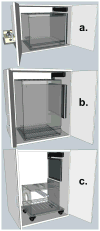Touchscreen technology in the study of cognition-related behavior
- PMID: 29064843
- PMCID: PMC5687822
- DOI: 10.1097/FBP.0000000000000356
Touchscreen technology in the study of cognition-related behavior
Abstract
There is a growing need for new translational animal models designed to capture complex behavioral phenotypes implicated in addiction and other neuropsychiatric conditions. For example, a complete understanding of the effects of commonly abused drugs, as well as candidate medications, requires assessments of their effects on learning, memory, attention, and other cognition-related behavior. Modern touch-sensitive technology provides an extremely flexible means to expose an experimental subject to a variety of complex behavioral tasks designed to assay dimensions of cognitive function before, during, and after drug administration. In addition to tailored variants of gold-standard cognitive assessments, touchscreen chambers offer the ability to develop novel tasks based upon the researcher's needs. This methods perspective presents (i) a brief review of previous touchscreen-based animal studies, (ii) a primer on the construction of a touch-sensitive experimental chamber, and (iii) data from a proof-of-concept study examining cross-species continuity in performance across a diverse assortment of animal subjects (rats, marmosets, squirrel monkeys, and rhesus macaques) using the repeated acquisition task - a modern variant of a traditional animal model of learning. Taken together, the procedures and data discussed in this review illustrate the point that contemporary touchscreen methodology can be tailored to desired experimental goals and adapted to provide formal similarity in cognition-related tasks across experimental species. Moreover, touchscreen methodology allows for the development of new translational models that emerge through laboratory and clinical discovery to capture important dimensions of complex behavior and cognitive function.
Figures


Similar articles
-
Touchscreen cognitive testing: Cross-species translation and co-clinical trials in neurodegenerative and neuropsychiatric disease.Neurobiol Learn Mem. 2021 Jul;182:107443. doi: 10.1016/j.nlm.2021.107443. Epub 2021 Apr 22. Neurobiol Learn Mem. 2021. PMID: 33895351 Review.
-
Evaluation of Touchscreen Chambers To Assess Cognition in Adult Mice: Effect of Training and Mild Traumatic Brain Injury.J Neurotrauma. 2017 Sep;34(17):2481-2494. doi: 10.1089/neu.2017.4998. J Neurotrauma. 2017. PMID: 28558476 Free PMC article.
-
A novel touch-sensitive apparatus for behavioral studies in unrestrained squirrel monkeys.J Neurosci Methods. 2012 Aug 15;209(2):331-6. doi: 10.1016/j.jneumeth.2012.06.028. Epub 2012 Jul 10. J Neurosci Methods. 2012. PMID: 22790109 Free PMC article.
-
Strain-dependent effects on acquisition and reversal of visual and spatial tasks in a rat touchscreen battery of cognition.Physiol Behav. 2015 May 15;144:26-36. doi: 10.1016/j.physbeh.2015.03.001. Epub 2015 Mar 3. Physiol Behav. 2015. PMID: 25744936
-
Translational cognitive neuroscience of dementia with touchscreen operant chambers.Genes Brain Behav. 2021 Jan;20(1):e12664. doi: 10.1111/gbb.12664. Epub 2020 Aug 18. Genes Brain Behav. 2021. PMID: 32374080 Review.
Cited by
-
A Multi-task Platform for Profiling Cognitive and Motivational Constructs in Humans and Nonhuman Primates.bioRxiv [Preprint]. 2023 Nov 13:2023.11.09.566422. doi: 10.1101/2023.11.09.566422. bioRxiv. 2023. PMID: 38014107 Free PMC article. Preprint.
-
Effects of cannabinoid exposure on short-term memory and medial orbitofrontal cortex function and chemistry in adolescent female rhesus macaques.Front Neurosci. 2022 Sep 30;16:998351. doi: 10.3389/fnins.2022.998351. eCollection 2022. Front Neurosci. 2022. PMID: 36248648 Free PMC article.
-
Multi-Domain Touchscreen-Based Cognitive Assessment of C57BL/6J Female Mice Shows Whole-Body Exposure to 56Fe Particle Space Radiation in Maturity Improves Discrimination Learning Yet Impairs Stimulus-Response Rule-Based Habit Learning.Front Behav Neurosci. 2021 Oct 11;15:722780. doi: 10.3389/fnbeh.2021.722780. eCollection 2021. Front Behav Neurosci. 2021. PMID: 34707486 Free PMC article.
-
Translational Assessments of Reward Responsiveness in the Marmoset.Int J Neuropsychopharmacol. 2021 May 18;24(5):409-418. doi: 10.1093/ijnp/pyaa090. Int J Neuropsychopharmacol. 2021. PMID: 33280005 Free PMC article.
-
Developmental Manipulation-Induced Changes in Cognitive Functioning.Curr Top Behav Neurosci. 2023;63:241-289. doi: 10.1007/7854_2022_389. Curr Top Behav Neurosci. 2023. PMID: 36029460 Free PMC article.
References
-
- Ator NA, Griffiths RR. Principles of drug abuse liability assessment in laboratory animals. Drug Alcohol Depend. 2003;70(3 Suppl):S55–72. - PubMed
-
- Belmonte JC, Callaway EM, Churchland P, Caddick SJ, Feng G, Homanics GE, Lee KF, Leopold DA, Miller CT, Mitchell JF, Mitalipov S, Moutri AR, Movshon JA, Okano H, Reynolds JH, Ringach D, Sejnowski TJ, Silva AC, Strick PL, Wu J, Zhang F. Brains, Genes, and Primates. Neuron. 2015;86:617–631. - PMC - PubMed
-
- Cook RG, Geller AI, Zhang GR, Gowda R. Touchscreen-enhanced visual learning in rats. Behav Res Methods Instrum Comput. 2004;36:101–6. - PubMed
Publication types
MeSH terms
Grants and funding
LinkOut - more resources
Full Text Sources
Other Literature Sources

